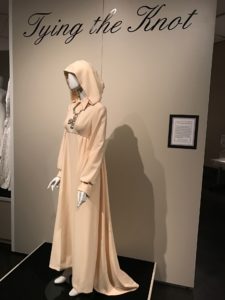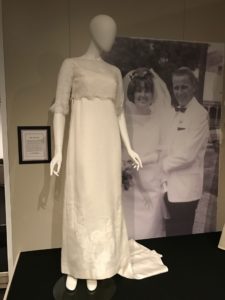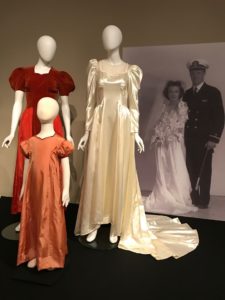 CSU’s Avenir Museum of Design and Merchandising has unveiled “Tying the Knot,” a new exhibition of bridal gowns, accompanied by photos and stories of many of the brides who wore them.
CSU’s Avenir Museum of Design and Merchandising has unveiled “Tying the Knot,” a new exhibition of bridal gowns, accompanied by photos and stories of many of the brides who wore them.
The exhibit, which runs through Aug. 11, was the brainchild of Megan Osborne, the Avenir’s curator and collections manager, who has long wanted to display a sample of the museum’s large bridal collection. The new exhibition represents only about 15 percent of those holdings.
“It came together exactly as I envisioned,” Osborne said. “I’m so pleased with it.”
The show will be front-and-center at the museum’s Thursday Evening Lecture Series on March 30, when CSU alumna Lauren Lotspeich will speak about the modern bridal apparel industry. After graduating in 2016 with a degree in design and merchandising, Lotspeich worked in the wedding gown design and construction industry in the United Kingdom. Now she works for Brilliant Bridal; in Denver as an alterations and bridal gown reconstruction specialist. Her talk begins at 7 p.m. in the Avenir, at 216 E. Lake St. in Fort Collins.
 Bridal stories
Bridal stories
The large-format historical photos of the brides help bring the gowns and their stories to life. One dress was made by CSU alumna Marka Weiss as her final college project, just before she graduated with a degree in home economics in 1965. She wore it the following August when she got married, then donated it to the Avenir on her 50th wedding anniversary.
“I tried to select a combination of traditional gowns and interesting or unique gowns,” Osborne said. “I also tried to pick dresses that have interesting stories.”
One of the dresses has a hood and was worn at the 1972 Greek Orthodox wedding of Antigone Kotsiopulos, former head of CSU’s Department of Design and Merchandising. Another was made in 1842 by the bride’s brother, who was a tailor. A third was made in 1946 from the silk of a parachute that the groom sent to his fiancée while serving in World War II.
“That is one of the star pieces in our entire collection,” Osborne explained. “And it’s getting pretty fragile, so this might be the last time it’s exhibited.”
 Groupings
Groupings
There is a set of three dresses worn by a bride, a bridesmaid and a flower girl. In addition, there is a duo — a bridal gown and the dress worn by the mother of the bride, accompanied by a black-and-white photo of the two making final preparations before the 1957 wedding.
Also on display is the simple dress worn by Virginia Loomis Cory, who had never left Iowa before her fiancé flew her to Santiago, Chile, where he was working at the time. They got married there in 1944.
“She didn’t understand what was said at her own wedding, because it was performed in Spanish,” Osborne said with a smile.
In addition to the gowns, the exhibition features samples of lace that have historically been used for bridal attire, from the Avenir’s Ruth Payne Hellmann Lace Collection.
“We hope people will come by and see it all for themselves,” Osborne said.
The Department of Design and Merchandising is part of CSU’s College of Health and Human Sciences.